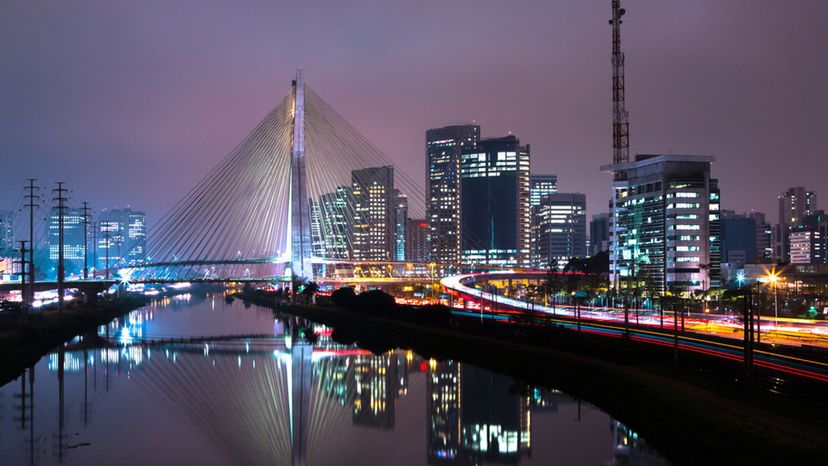
About This Quiz
Family rural living is a dying way of life everywhere in the world. People are flocking to cities, swelling them in size to the point that they become megacities. How much do you know about the megacities of the Earth?"Megacity" is an overarching term often used to describe metropolitan areas with 10 million or more people. They are the most populous cities on Earth.
Asia is the world's biggest continent, home to billions of people. And it includes the top six megacities.
Tokyo, Japan is currently the world's biggest megacity. It is a sprawling monstrosity of a metro area, with nearly 39 million people, roughly the same number as the entire state of California.
Advertisement
There are 37 cities around the globe with populations of 10 million or more. Some have a great quality of life, others aren't necessarily the most desirable places to live.
Tokyo has more people than any other city. And it has the biggest city economy, too, with a gross domestic product of around $2 trillion.
In developing countries, many millions of people are flocking to urban areas in search of new economic opportunities. The influx of new urbanites means that developing countries have the fastest-growing cities on Earth.
Advertisement
With a total metro area population of more than 26 million souls, NYC is definitely a megacity. It's the seventh-largest city on Earth.
Beginning in the 18th century, the Industrial Revolution altered human activity by making many manual farming tasks easier. Freed from farms, countless numbers of people moved to cities for different work.
There are three megacities in North America: New York, Los Angeles and Mexico City. Mexico City has a total population of around 22 million.
Advertisement
The Greater Jakarta megacity is in Indonesia. It's the second-largest metro area in the world, with more than 31 million people.
Cairo is the biggest city in Egypt, and also the largest city in Africa. Nearly 19 million people live there.
Subsistence-based villages offer a very low quality of life. So low, in fact, that for multitudes of people the squalid slums of a megacity are a better option.
Advertisement
Seoul is the capital of South Korea. It is currently ranked as the third-largest city in the world.
In 1950, the world's population was mostly rural. There were just two megacities -- New York City and Tokyo. Now, the script has been flipped.
Delhi is a gigantic Indian city of around 22 million people. It is the 10th-largest city in the world.
Advertisement
Shanghai is an enormous Chinese megacity, the biggest in the country. More than 24 million people make their homes there.
Karachi is an enormous city in Pakistan. It's also a hub of liberalism in an area that's not necessarily known for open-minded politics.
NYC isn't just heavily populated, it also sprawls in terms of infrastructure. It covers about 5,000 square miles, more than any other city.
Advertisement
Shanghai is a densely-populated Chinese city. It's the most populous city proper in the world, with more than 24 million inhabitants.
Huge cities in poor countries mean massive slums -- areas where people live in poverty-stricken circumstances. But on a happier note, in many of the biggest cities, the number of people living in slums is actually decreasing.
São Paulo is a big city in Brazil. With more than 20 million inhabitants, it is currently the 12th-biggest metro area in the world.
Advertisement
Mumbai is a megacity found in India. More than 18 million people live there, making it the most populous city in all of India.
Africa lags behind in urbanization compared to much of the rest of the world. So far behind, in fact, that it won't reach 50 percent urbanization until around 2035.
In 1990, there were just 10 megacities. Now, there are 37. By 2030, the U.N. projects that there will be 41 megacities on Earth.
Advertisement
Karachi is a huge city in Pakistan. With its population of more than 24 million, it is much bigger than Moscow (17 million) and L.A. (18.5 million).
Chicago is nowhere near megacity status. It has a population of fewer than 3 million people.
Jabodetabek is name often used for Greater Jakarata. The name is derived from the first two or three letters of the regions that make up the city: Jakarta, Bogor, Depok, Tangerang and Bekasi.
Advertisement
North America has just three megacities, but it has the world's highest percentage of urbanization, at more than 82 percent. On some less-developed continents, the level of urbanization hasn't reached even 50 percent.
There's no contest here -- Greater Jakarta (Indonesia) is the world's second-biggest megacity. Manila (Philippines) has a population of around 24 million.
Urbanization is a clear trend. The U.N. projects that by 2050, 70 percent of all humans will live in some sort of metropolitan area.
Advertisement